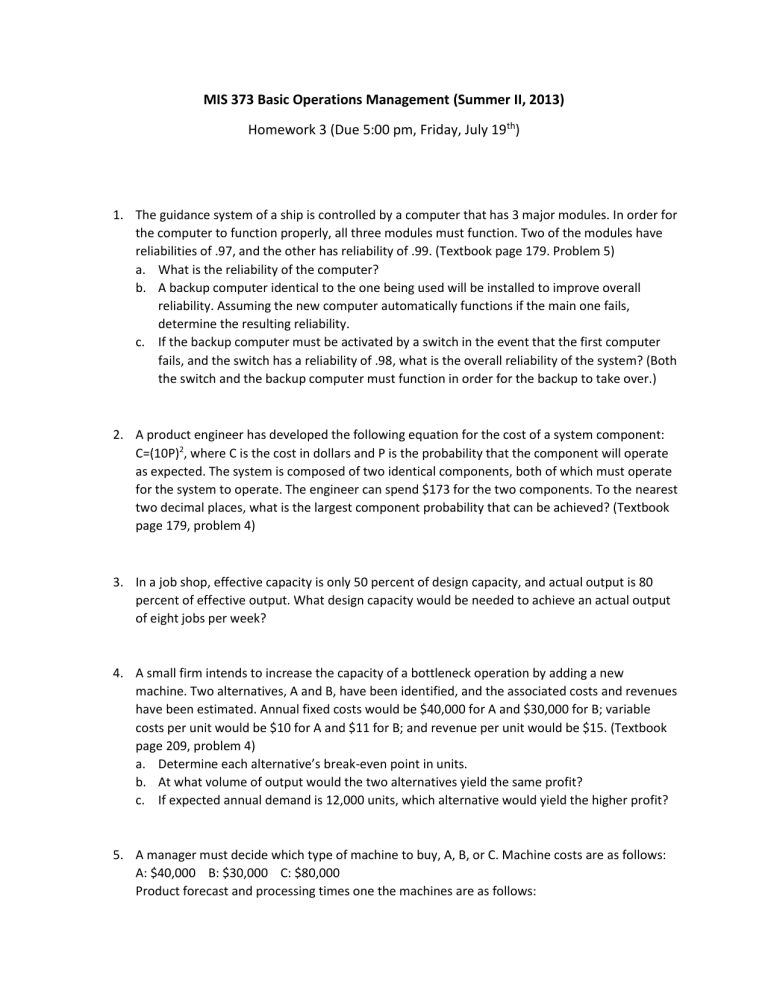Homework3 - U

MIS 373 Basic Operations Management (Summer II, 2013)
Homework 3 (Due 5:00 pm, Friday, July 19
th
)
1.
The guidance system of a ship is controlled by a computer that has 3 major modules. In order for the computer to function properly, all three modules must function. Two of the modules have reliabilities of .97, and the other has reliability of .99. (Textbook page 179. Problem 5) a.
What is the reliability of the computer? b.
A backup computer identical to the one being used will be installed to improve overall reliability. Assuming the new computer automatically functions if the main one fails, determine the resulting reliability. c.
If the backup computer must be activated by a switch in the event that the first computer fails, and the switch has a reliability of .98, what is the overall reliability of the system? (Both the switch and the backup computer must function in order for the backup to take over.)
2.
A product engineer has developed the following equation for the cost of a system component:
C=(10P) 2 , where C is the cost in dollars and P is the probability that the component will operate as expected. The system is composed of two identical components, both of which must operate for the system to operate. The engineer can spend $173 for the two components. To the nearest two decimal places, what is the largest component probability that can be achieved? (Textbook page 179, problem 4)
3.
In a job shop, effective capacity is only 50 percent of design capacity, and actual output is 80 percent of effective output. What design capacity would be needed to achieve an actual output of eight jobs per week?
4.
A small firm intends to increase the capacity of a bottleneck operation by adding a new machine. Two alternatives, A and B, have been identified, and the associated costs and revenues have been estimated. Annual fixed costs would be $40,000 for A and $30,000 for B; variable costs per unit would be $10 for A and $11 for B; and revenue per unit would be $15. (Textbook page 209, problem 4) a.
Determine each alternative’s break-even point in units. b.
At what volume of output would the two alternatives yield the same profit? c.
If expected annual demand is 12,000 units, which alternative would yield the higher profit?
5.
A manager must decide which type of machine to buy, A, B, or C. Machine costs are as follows:
A: $40,000 B: $30,000 C: $80,000
Product forecast and processing times one the machines are as follows:
Product
#1
#2
#3
#4
Annual Demand Processing time per unit (minutes)
A B
16,000
12,000
3
4
4
4
6,000
30,000
5
2
6
2
C
2
3
4
1
(Textbook page 210, problem 10) a.
Assume that only purchasing costs are being considered. Which machine would have the lowest total cost, and how many of that machine would be needed? Machines operate 10 hours a day, 250 days a year. b.
Consider this additional information: The machines differ in terms of hourly operating costs: the A machines have an hourly operating cost of $10 each, B machines have an hourly operating cost of $11 each, and C machines have an hourly operating cost of $12 each.
Which alternative would be selected, and how many machines, in order to minimize total cost while satisfying capacity processing requirements?



